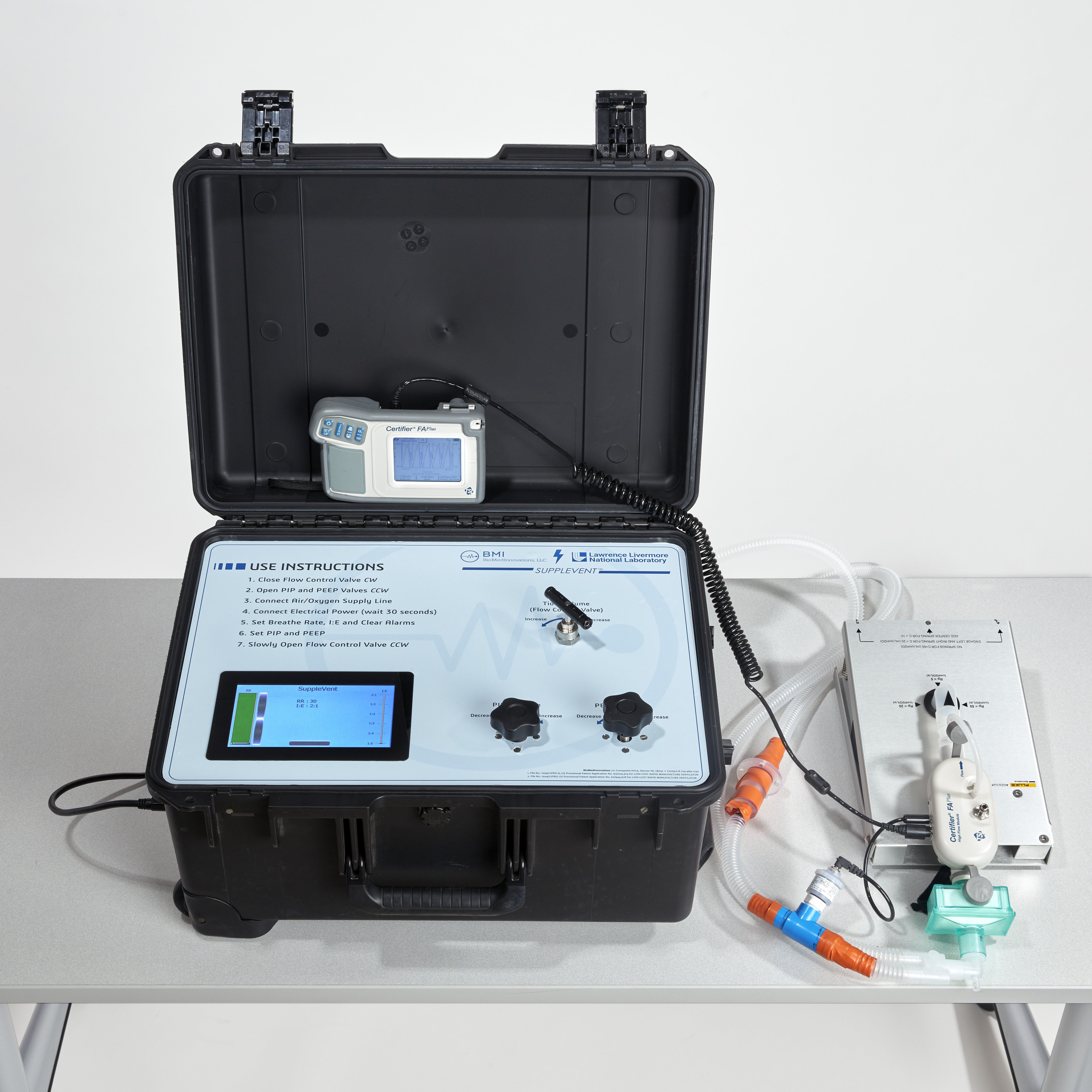LLNL and medical device startup company BioMedInnovations (BMI) have reached an agreement to develop a commercialized ventilator — a machine that helps patients breathe when they are unable to do so on their own — that can be easily built from readily available parts. Branded as SuppleVentTM, the ventilator is designed to meet the functional requirements of COVID-19 patients suffering from Acute Respiratory Distress Syndrome (ARDS) and other serious breathing difficulties. The FDA evaluated the prototype and authorized it for emergency use, where it could provide relief in places where ventilators are in short supply, such as underdeveloped countries or hospitals in rural areas, or in the event of a sudden resurgence of disease transmission.
“It feels spectacular to have a chance to contribute to the cause,” said engineer Jack Kotovsky, who spearheaded the ventilator effort. “I think all of us want to contribute and help individuals in all dimensions of the pandemic. Producing a piece of durable equipment that will directly benefit human life is very exciting. The need is still there globally. Knowing that we are providing a buildable and scalable design that is high-functioning and affordable means we are in the game and it’s important to continue.”
The novel ventilator is the product of countless hours of design, prototyping and testing by LLNL and BMI engineers and scientists – many of them working from home – and outside clinicians and medical experts who formed an ad hoc team to respond to a predicted shortfall of ventilators due to the COVID-19 pandemic. With the cooperative research and development agreement (CRADA) in place and FDA approval secured, BMI can now sell the machines to hospitals and clinics.
“It is a true testament to the technical ability of this team, as well as the commitment to serve the public in a time of urgent national need, that the ventilator went from a design concept to a functional prototype in a matter of a few weeks despite all of the work restrictions that were in place at the time,” said LLNL’s Associate Director for Engineering Anantha Krishnan. “We are very proud of the engineers and scientists who came together to enable this amazing accomplishment. With the BMI partnership in place, we hope that this device will now be available widely to meet the needs of many communities in this fight against the pandemic.”
The North Carolina-based BMI specializes in machines used for tissue and organ perfusion —devices that help blood and other fluids flow through harvested organs to keep them alive outside of the body for transplantation or research. BMI will produce the ventilators, engage with potential customers and distribute the machines. The cost of each unit is expected to be a fraction of that of commercial ventilators, and the company is already receiving interest from foreign countries for orders.
“When we realized we were facing a pandemic, it was without reservation that we changed our focus at BMI and immediately began researching how to use our technology to design an emergency use ventilator. It has been an amazing opportunity to partner and work with the team at LLNL as our vision and purpose — to save lives — have been aligned from the start,” said BMI’s Chief Operating Officer Carrie DiMarzio. “It’s profound to see what once may have been seen as impossible be made possible by two teams on opposite coasts working voluntarily, selflessly and together to help others.”
“Personally, having a focus on saving lives from COVID-19 allowed me and the company to have a focus much bigger than ourselves, which made quarantine easier,” said BMI CEO Sherif Gabriel.
The project got a boost from the world of motorsports, which was on pause during the crisis. Through BMI’s relationship with Industrial Hard Carbon (the two companies share an owner), the partnership brought in NASCAR racing teams Roush Yates Manufacturing Solutions (RYMS) and Joe Gibbs Racing to build components for the ventilator. Indy Car engine designer Honda Performance Development assisted with testing and engineering expertise. The ventilators themselves will be assembled by RYMS, a division of Roush Yates Engines, which builds Ford engines for multiple NASCAR teams. RYMS also designs and builds components for the aerospace, defense, medical and automotive industries.
Beginning in March, as COVID-19 cases began to surge, a “skunk works” team of more than 20 LLNL engineers and scientists, along with a handful of outside collaborators, began designing a simple ventilator that could serve as a stopgap solution until ventilator manufacturers could catch up to anticipated demand. It would need to be easy to operate and quickly assembled from parts not typically used in ventilator manufacturing, to avoid disrupting supply chains.
Working long hours with clinicians, doctors and ventilator manufacturers, and researching existing literature on ventilators, the team came up with two promising prototypes in the span of just two weeks. One design, borrowing ideas from a team in Italy, used a tube submerged in a column of water to regulate air pressures. The other prototype, called the “RV-22,” was named for a precise low-pressure regulator developed by Equilibar, a BMI partner company. The RV-22 design won out due to its simplicity, functionality and part availability, and the Lab began partnering with BMI to produce several iterations of what would eventually become the SuppleventTM prototype.
“It was a unique and exciting experience given the extremely dynamic nature of the pandemic — which often would change our project course daily or even hourly — as well as the fact that everything had to be orchestrated remotely,” said research engineer David Soscia, project manager for the first five weeks of the effort. “It was amazing to see a group of dedicated Lab employees and external collaborators, many who have never met in person, work tirelessly around the clock to make an impact on the health and safety of others.”
“This entire experience has been inspiring, especially in the way that I saw people from across LLNL and our outside partners band together for this project,” said research engineer Allison Yorita, team lead in regulatory affairs and project manager after Soscia transitioned off the project. “I learned how we could innovate and rapidly develop a solution, even though many of us were separated in our respective living rooms.”
Designed for portability, the suitcase-sized ventilator has a simple user interface and large LCD display for monitoring pressures and air flow, circuits for inhalation and exhalation that are controlled by highly accurate pressure regulators and alarms to alert users if pressures fall out of range or if a system failure occurs. It can operate in a continuous ventilation mode but can adapt to patients who spontaneously breathe on their own and is designed to be retrofitted to include additional functionality in the future.
“I’m incredibly impressed by how effectively a team of Lab employees can hammer on a problem and draw upon a vast set of capabilities, know-how and resources to affect a solution in a remarkably short amount of time,” Kotovsky said. “The Lab is well-suited to addressing this type of a national problem, where we have a lot of tools, hardware and capabilities on-site. Most importantly, we have an incredibly capable and dedicated workforce that is eager to jump in. I welcome us having an on-ramp to doing this kind of work readily in the future.”
Even with an FDA-approved prototype in place, the ventilator team is continuing the work with funding from the Department of Energy to improve functions for future iterations and explore wholly new approaches for ventilating patients. The team is exploring gas exchange techniques, methods for capturing and recirculating expelled oxygen and alternate ways to oxygenate the blood.
For more on LLNL’s COVID-19 response efforts, visit www.llnl.gov/coronavirus
Original post https://alertarticles.info



